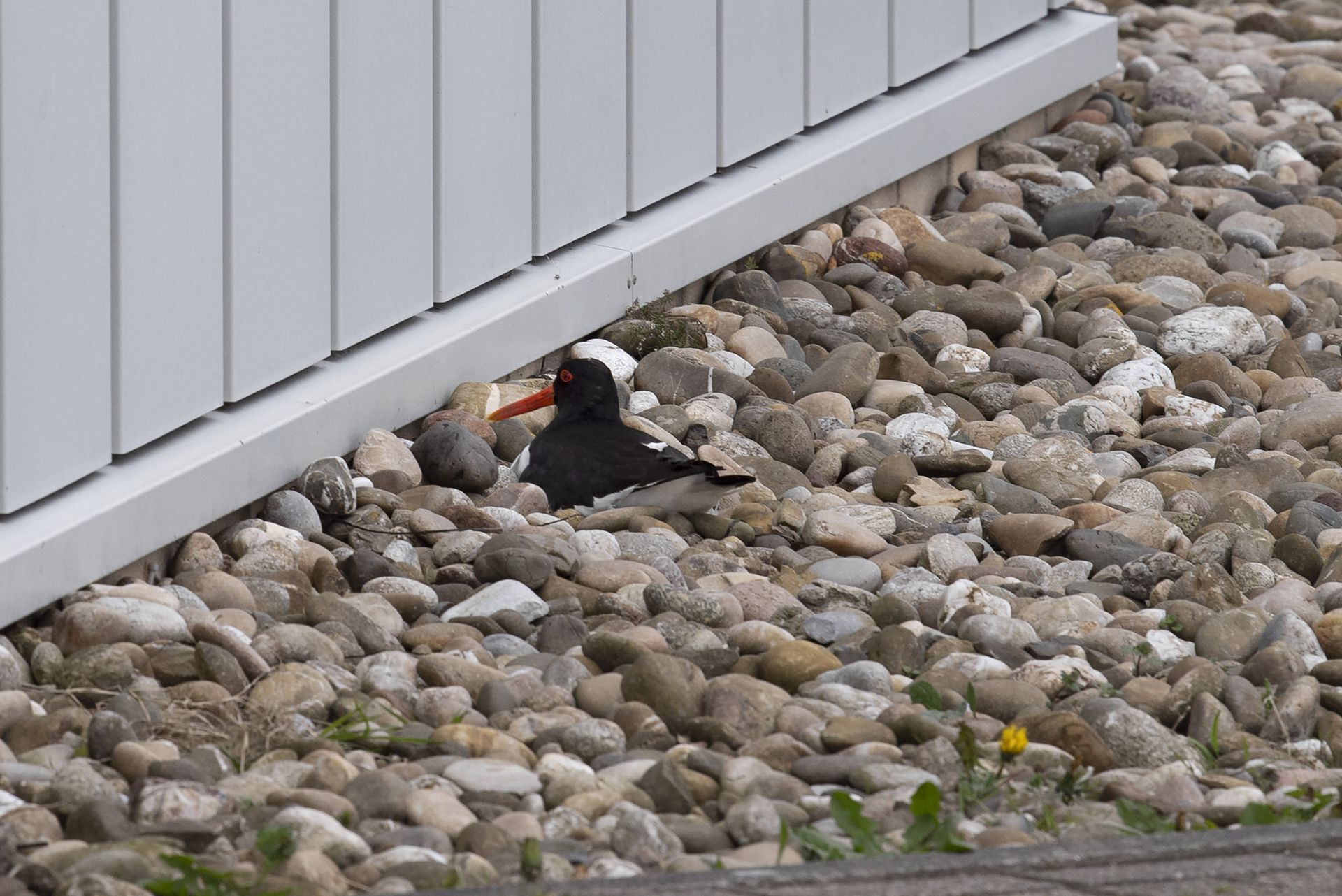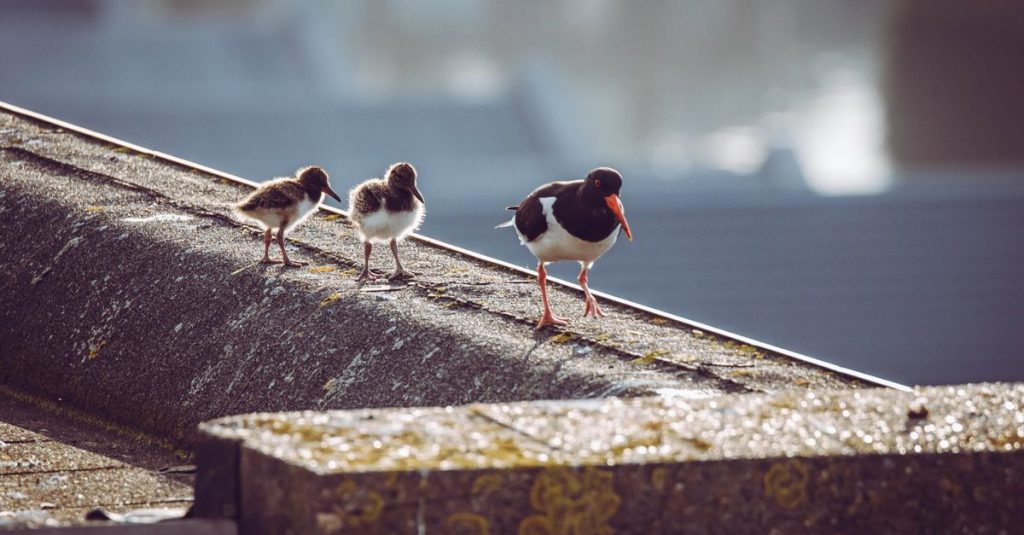Tepíét-tepíét-tepíét-tepíét! It’s unmissable, the piercing call of the oystercatcher. Nature lovers are familiar with the sound of polders and salt marshes. But it’s also increasingly being heard from rooftops, in villages, cities and industrial areas. The oystercatcher, a distinctive black-and-white shorebird with bright red legs and bill, is increasingly breeding on flat roofs in urban areas in the Netherlands.
The scene is often fraught with danger: the parent birds nest steadily in full sun on a gravel bed, keeping the seagulls away or protecting their brood from the harsh weather. Then the chicks themselves: they move quickly, often walking dangerously close to the edge. Sometimes they bounce off the roof before they can fly. Then they have to navigate on foot between cats and traffic, their parents squawking loudly above them.
Often, everything goes well. A relatively large number of young are born in urban areas. An average of 0.42 young per pair survive each breeding attempt: slightly more than is necessary to maintain the population. And at least three times as many as elsewhere. The urban population is growing, both in percentage terms and in absolute terms. In 2009, only about 4 percent of oystercatchers nested on roofs; now it is 20 percent. In 2009, this included 3,500 to 4,000 pairs in urban areas; now there are twice that number.
significant decrease in population
But a quick calculation shows that the total number of Dutch oystercatchers has fallen dramatically over those 15 years. In 2009 there were around 87,000 to 100,000 breeding pairs. Now there are only 30,000 to 37,000. The figures were released in mid-July by the Dutch bird research company Sophon and the Bird Conservation Society. out together Oystercatcher Year 2023 Results.
The reasons for the decline are varied, says Timo Ruecki of Bird Protection. “Oystercatchers suffer from the same ‘stressors’ as other birds in rural areas, such as lapwings and lapwings,” he says. “In many agricultural areas, it is difficult to raise young.”
In heavily fertilized, drained and mowed meadows, many nests are lost and chicks are finding little food. Disturbance, pollution and increased predation also play a role, as do the flooding of nests along the coast. “Oystercatchers are moving into the city,” says Rocky. “That’s not necessarily a positive development. It’s a necessary development. But that doesn’t change the fact that it’s a great thing that these urban birds are doing so well.”
They don’t need much for their nests.
Oystercatchers are opportunists, explains Rocky. They seize opportunities where they see them. “They find food everywhere, including along roadsides and on football fields,” he says. Along the coast, they like to eat shellfish, but also worms and other bottom animals. They also find such food in the city. “And they don’t need much for their nests. They make a shallow hole, putting gravel in it where possible. That’s one of the reasons why many flat surfaces are so suitable.

But this urban life also has its risks. “Sometimes the young ones disappear into the drain,” says Rocky. “You can easily prevent that by putting a cheap cover over the drain or a net.” Another risk is predation by gulls, birds of prey or cats. Then you have the rain and the extreme heat. Sometimes the roofs get so hot that the chicks jump out prematurely and fall to their deaths. “Here and there, experiments are being done with rooftop canopies, which provide more shelter for the birds. Our first impressions are positive.”
In 15 years, will all the oystercatchers in the city be reproducing? Rocky doesn’t hope so. “We would certainly prefer to see their chances improve in the countryside,” he says. “Oystercatchers really belong to our marshes and saltlands. If we lose this species there, it says a lot about us and how we interact with our environment.”
Meanwhile, he and his colleagues are working to create more bird-friendly cities. Not just in the form of shelter, but especially through more green space in and around the city. Then the oystercatchers will find food more easily. “Will their urban growth continue? I find it hard to predict. Sometimes it seems like a trend, but five years later it turns out to be different.”
Perhaps the best-studied group of oystercatchers in the world: the inhabitants of the Schiermonnikoog salt marsh. Dutch biologists have been studying oystercatchers for nearly half a century. The driving force in the first three decades has been Bruno Enns, a researcher at Sofon and founder of Sofon. SOS Oystercatcher Research FoundationThis has resulted in dozens of theses and master’s theses on these striking birds, which sometimes live up to forty years and often choose a mate for life. Thanks to the colored rings, scientists can identify individual oystercatchers. Over the years, they have been able to unravel the dynamics of this group in detail, including territorial disputes, “second-degree brothers” and dramatic changes in partners.

But in the past 40 years, the population has shrunk by as much as 80 percent. Oyster fishing, exotic oysters, warmer seawater, disturbance, and the condensation and drying of surrounding farmland have all taken their toll. “Our national bad luck bird,” biologists have called the oystercatcher. Even opportunistic species that feel at home everywhere have shown they can decline in numbers.
Now a new culprit has emerged: rising sea levels. Long before salt marshes are submerged, and even if we “die” as sea levels rise, shorebirds have to contend with losing their nests to frequent flooding. Which? An international research team reported In July The nature of climate changeEven if warming stays below 2°C, the number of oystercatchers on the three Wadden Islands will fall by an additional 56 to 79 percent over the next 100 years due to sea level rise, on top of the 2 percent annual decline already occurring for other reasons.
Choosing a regional location is risky, says first author Martijn van de Pol, a former group leader at the Netherlands Institute for the Environment (NIOO-KNAW), now based in Australia. “On the one hand, as an oystercatcher, you want to breed as close to the mudflats as possible, because that’s where you find your food, but on the other hand, you’d rather be a little higher up so you can get a little bit higher up and reduce the risk of flooding,” he explains.
Scientists often debate the question: Can salt marshes grow large enough as sea levels rise? Van de Pol: “We discovered that there is another question that is even more relevant to oystercatchers: How often do salt marshes flood during the breeding season? We will likely lose the surface of the salt marshes to the sea later this century. But long before then, the habitat becomes less suitable.”
Severe storms in Wadden
The sea level is now rising at an average rate of 3 to 4 mm per year, but the highest water level is rising twice as fast, due to strong storms that push the Wadden Sea water up. “The nests are already flooded more than before,” says co-author Eilke Jongegans from Radboud University in Nijmegen. “In the past two decades, on average, about four times more than in the previous two decades. On average, a breeding pair in the salt marshes now produces only 0.15 young per year. That would need to be at least 0.35 to 0.4 to maintain the population.”
This reduced reproductive success is not only due to sea level rise, but also to other stressors, such as shellfish harvesting, Jungejans stresses. “In addition to changes in agricultural land. In winter and during high tides, the birds feed in grasslands. This is very important for their survival and reproductive success. But then those grasslands have to provide enough food.”
The long-term research received a major boost after two years of using the oystercatcher (in 2023 and 2008). The work continues thanks to dedicated volunteers. For example, many people, encouraged by Sovon, Bird Protection and SOS, have observed the oystercatchers using coloured rings. Van de Pol:Citizen science It is very valuable for us, for example, to be able to extend the results to the whole of the Faden region. And it is also very fun, he emphasizes. “There are a lot of people who feel involved in this genre.”

“Coffee buff. Twitter fanatic. Tv practitioner. Social media advocate. Pop culture ninja.”











More Stories
Which can cause an increase in nitrogen.
The Central State Real Estate Agency has no additional space to accommodate Ukrainians.
Fewer PIMs in dementia patients with immigrant background